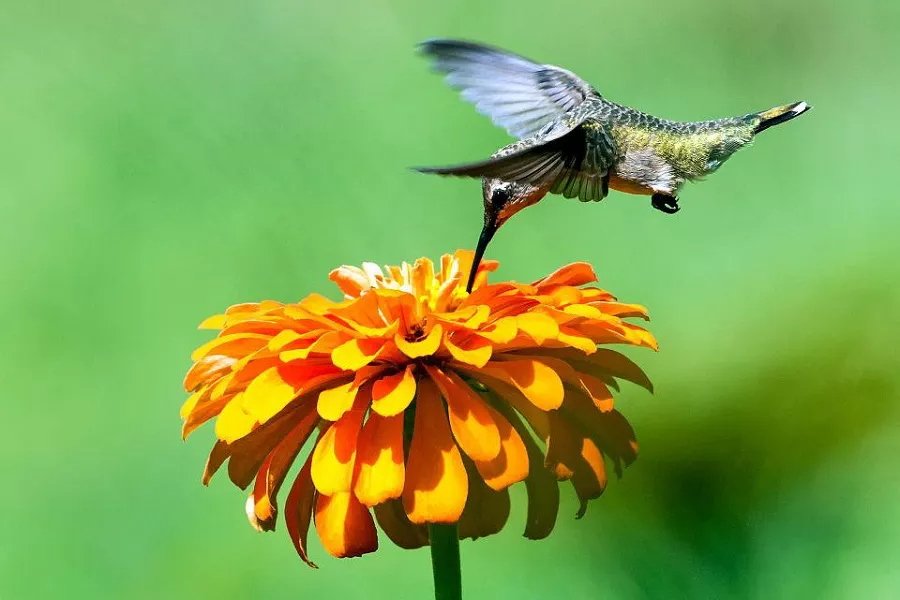Hummingbirds are fascinating creatures that have captured the attention of bird watchers and nature enthusiasts around the world. These tiny birds are known for their unique feeding habits, which involve consuming nectar from flowers using their long beaks and tongues. If you’re interested in attracting hummingbirds to your garden or backyard, you may be wondering if they like zinnias. In this article, we’ll explore the relationship between hummingbirds and zinnias and provide insights into how you can create a hummingbird-friendly environment in your own backyard.
Understanding Hummingbirds’ Feeding Habits
Before we delve into the specifics of whether hummingbirds like zinnias, it’s essential to understand their feeding habits. Hummingbirds are primarily nectar feeders, meaning they consume the sweet liquid found in flowers. In addition to nectar, hummingbirds also feed on small insects and spiders, which provide them with essential protein.
To obtain nectar from flowers, hummingbirds use their long, slender beaks to probe the center of the flower. They then extend their tongues up to twice the length of their beaks, which are covered in tiny hairs that help them lap up the nectar. Because hummingbirds have such high metabolisms, they must consume large amounts of nectar to sustain their energy levels throughout the day.
Do Hummingbirds Like Zinnias?
Now that we’ve established hummingbirds’ feeding habits let’s explore whether they like zinnias. The short answer is yes, hummingbirds do like zinnias. Zinnias are bright, colorful flowers that produce plenty of nectar, making them an excellent food source for hummingbirds.
Zinnias come in a variety of colors, including red, orange, pink, yellow, and purple. While hummingbirds are attracted to all these colors, they seem to be especially drawn to red and orange hues. When selecting zinnias for your garden or backyard, consider planting a mix of colors and varieties to attract a diverse range of hummingbird species.
The Allure of Zinnias for Hummingbirds
1. Colorful Blooms:
Hummingbirds are instinctively drawn to bright, vibrant hues, especially those in the red spectrum. Zinnias, available in a wide array of shades including red, orange, pink, and purple, provide a visual feast for these tiny avian visitors. The bright, eye-catching colors of zinnias act as beacons, signaling to hummingbirds that a potential nectar source awaits.
2. Nectar Production:
Zinnia flowers are known for their copious production of nectar. Hummingbirds have long beaks and tongues designed to reach deep into flowers, extracting nectar from its source. Zinnias’ funnel-shaped blooms and elongated tubular structures make them accessible and conducive to the feeding habits of hummingbirds. The abundance of nectar serves as a reliable energy source, attracting hummingbirds to zinnias and encouraging them to return repeatedly.
3. Continuous Blooming:
Another factor that contributes to the allure of zinnias for hummingbirds is their extended blooming period. Zinnias are often cultivated as annual plants, providing continuous blooms throughout the summer and into fall. This extended flowering season ensures a consistent supply of nectar for hummingbirds, making zinnias an attractive choice for these nectar-loving birds.
4. Garden Placement:
Strategic garden placement can also enhance the appeal of zinnias to hummingbirds. Planting zinnias in proximity to other nectar-rich flowers or incorporating them into a hummingbird-friendly garden design can create an inviting oasis for these winged visitors. By offering a variety of nectar sources, zinnias can complement other flowers favored by hummingbirds, further increasing the likelihood of attracting these delightful creatures.
Creating a Hummingbird-Friendly Environment
If you’re interested in attracting hummingbirds to your garden or backyard, there are several steps you can take to create a welcoming environment. Here are some tips to get you started:
1. Plant flowers that produce plenty of nectar:
As we’ve discussed, hummingbirds primarily feed on nectar, so planting flowers that produce plenty of this sweet liquid is essential. In addition to zinnias, other hummingbird-friendly flowers include bee balm, salvia, and trumpet vine.
2. Provide a water source:
Hummingbirds need water to drink and bathe in, so providing a water source is crucial. Consider installing a bird bath or a shallow dish filled with water in your garden or backyard.
3. Avoid using pesticides:
Pesticides can be harmful to hummingbirds and other wildlife, so avoid using them in your garden or backyard. Instead, opt for natural pest control methods such as companion planting and handpicking insects.
4. Hang a hummingbird feeder:
If you want to supplement the nectar-producing flowers in your garden, hang a hummingbird feeder. Make sure to clean the feeder regularly to prevent the growth of mold and bacteria.
5. Create a sheltered environment:
Hummingbirds need shelter to rest and protect themselves from predators. Planting shrubs and trees in your garden or backyard can provide a safe haven for these tiny birds.
Conclusion
Hummingbirds are fascinating creatures that bring beauty and joy to any garden or backyard. By planting hummingbird-friendly flowers like zinnias and providing a welcoming environment, you can attract these tiny birds to your outdoor space and enjoy their presence throughout the year. Whether you’re a seasoned bird watcher or new to gardening, creating a hummingbird-friendly environment is a rewarding and fulfilling experience.


 Facebook
Facebook  Instagram
Instagram  Youtube
Youtube 